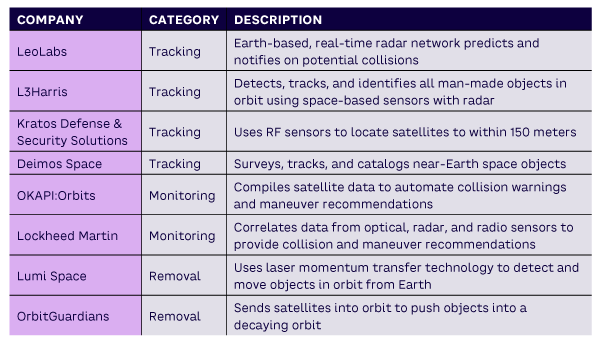AMPLIFY VOL. 37, NO. 2

Humanity has been going to space since Soviet cosmonaut Yuri Gagarin led the way in 1961. We’ve had a permanent human presence in the International Space Station (ISS) since 2001. New satellite constellation companies appear every year. The US and China plan to reestablish human presence on the Moon by the decade’s end. But our access to space is at risk — not because there aren’t enough people investing in it, but because Earth’s orbit is becoming too cluttered. Much like the depiction in Pixar’s film Wall-E, if Earth’s orbit becomes filled with satellites and debris, we risk not being able to leave our atmosphere at all.
To discuss this growing issue, we must understand why space is crucial to humanity, what the space waste challenge is, and how we can address it.
First Off, Why Go to Space?
One reason is that the space economy is currently valued at US $469 billion and is set to surpass $1 trillion in the next decade.1 There’s a lot of money to be made! But that’s the boring answer. It also doesn’t answer the pressing question: why should we go to space?
Investment in our presence in the stars has recently increased dramatically. It would be too easy to reduce this change to a few billionaires playing with their money. Instead of spending billions on rockets, why don’t they invest in saving the planet? Healthcare? Clean energy? Artificial intelligence (AI) and quantum computing? Hunger and poverty? Connectivity? Space skeptics pose these questions — and they are all valid!
Ironically, investment in space addresses all these issues, and many more:
-
Space mining replaces mining Earth for finite resources, such as rare earth metals, helium-3, and water.
-
Manufacturing and travel in space can help reduce CO2 emissions.
-
Extending the human lifespan and production of lifesaving drugs are key to making us a multi-planetary species.
-
Clean energy like fission, fusion, and solar is essential for sustainable colonies.
-
Robotics, AI, and quantum are needed to operate in space efficiently and safely.
-
Earth observation satellites monitor our farms, weather, crop output, water management, and more.
-
Satellite constellations connect the globe, including the 40% with little or no Internet access.
These technologies are being developed by space, for space — with real Earth applications. They are the reasons we need to invest in space, but if that isn’t enough, listen to Elon Musk’s words: “Fundamentally, the future is vastly more exciting and interesting if we’re a spacefaring civilization and a multi-planet species than if we’re not.”2
So What’s the Problem?
We’re at a turning point in the space industry, with costs to orbit having decreased by several magnitudes. NASA’s Space Shuttle sent payload to low Earth orbit at a rate of $54,500/kg.3 SpaceX sends payload for $2,800/kg with Falcon 9 and around $1,400/kg for Falcon Heavy. Starship could go as low as $50/kg when it’s fully operational and optimized.4
Economic opportunities in orbit and beyond are flourishing, and many countries and private operators are investing in satellite constellations in orbit. In 1978, NASA scientist Donald J. Kessler predicted that Earth’s orbit could eventually become so overpopulated that object/satellite collisions would lead to a chain reaction of collisions, making orbit and space access impossible. This is called the “Kessler Syndrome.”
With more than 7,000 active satellites, projections to reach 100,000 by 2030, and 100 million+ objects larger than 1 mm (from flecks of paint to out-of-commission satellites) in orbit, the Kessler Syndrome is increasingly probable. To deal with collision risks, operators must carefully track and predict their satellites in orbit, accurately track objects and debris in their path, rely on accurate collision algorithms to predict their risk of collision, and act to avoid them.
Satellite operators must exponentially increase their satellite maneuvers due to collision warnings. However, collision warnings are estimations, not predictions, based on inaccurate object detection, resulting in estimations of orbits and probabilities of collisions. These are almost always false positives. NASA’s threshold to maneuver a satellite is a 1 in 10,000 chance of collision, whereas SpaceX’s Starlink constellation has a threshold of 1 in 100,000.
As a result, SpaceX’s Starlink satellite constellation reported 25,000 avoidance maneuvers between 1 December 2022 and 31 May 2023. That number has been doubling every six months since 2019. It’s expensive and getting exponentially worse as we approach 100,000 satellites by 2030. At this rate, they would have 1 million maneuvers by 2028, a hugely inefficient way to manage a satellite constellation.5
Government agencies are starting to prioritize efforts to accurately monitor space debris and remove it. In October 2022, the Orbital Sustainability (ORBITS) Act was passed by the US Senate to outline Space Traffic Management (STM) measures NASA must take to develop monitoring and removal capabilities, align on new debris-mitigation practices, and develop standard practices to coordinate orbit traffic.6
So How Do We Solve It?
The first step is policy making. Before we can introduce new technologies to resolve the problem, we need to ensure it doesn’t get worse. The ORBITS Act was a step in the right direction.
The ORBITS Act was passed again by the Senate in October 2023 but was not considered by the House of Representatives, requiring its reintroduction in the House in 2024. This marks the Senate’s second approval of a version of the ORBITS Act (which received unanimous consent in the late 2022 Senate session but was also not addressed by the House). The proposed legislation instructs NASA to initiate a program for the removal of orbital debris. It would require collaboration among NASA, other government agencies, and the private sector to publish a list of debris objects that present the most imminent risk to the safety and sustainability of orbiting satellites.7 The US Federal Aviation Administration (FAA) also recently proposed a rule that would limit satellite life in orbit after the end of operation to five years.8
On the global front, in a collaborative initiative with the European Space Agency (ESA), the World Economic Forum released its “Space Industry Debris Mitigation Recommendations” in June 2023, aimed at fostering space sustainability.9 At the time of publication, the document had received 27 signatures from industry players in the space domain. This document, updated from its previous edition,10 urges increased collaboration among space actors to minimize space debris, better transparency among operators, accelerated innovations in spacecraft-disposal technologies and practices, and the elimination of existing space debris in orbit. It also outlines specific objectives for post-mission disposal success and a designated time frame for an object’s orbital lifespan.11
Within the United Nations (UN) Office for Outer Space Affairs (UNOOSA), the UN Committee on the Peaceful Uses of Outer Space (COPUOS) Working Group on the Long-Term Sustainability of Outer Space Activities addresses space debris and associated regulations and guidelines.12 Member states share information on their space debris research annually at the committee’s Scientific and Technical Subcommittee meeting. A compendium of space debris–mitigation standards can be found on UNOOSA’s website.13
International treaties and agreements, combined with government policies and regulations, enable collaboration among nations, space agencies, and private entities to set shared standards, reduce new debris generation, and encourage responsible behavior in space.
Key Technologies for Tracking, Monitoring & Removal
Addressing the Kessler Syndrome starts by accurately tracking everything in space, no matter how small. A 1-mm-wide fleck of paint might seem like nothing, but when traveling at 17,500 mph, it could cause severe damage to the ISS, endangering human life. Algorithms only work if they are fed good data. Table 1 lists some technologies that could help in tracking, monitoring, and removal. The following sections describe each technology.

LeoLabs
LeoLabs has developed an Earth-based, global radar network that tracks space objects in real time and populates a dynamic living map of tracked objects. Its proprietary algorithms predict and notify of potential collisions, recent maneuvers, and patterns throughout an object’s or satellite’s operational life. The radar network:
-
Covers 300-2,500 km in altitude
-
Tracks 250,000 objects, with >2 cm capability, 10x a day
-
Focuses on radar over laser (radar is more efficient for scanning an area, laser is more effective for tracking a specific object)
L3Harris
L3Harris provides a system that detects, tracks, and identifies all man-made objects in orbit. It combines ground- and space-based sensors with radar technologies.
Kratos Defense & Security Solutions
Kratos Defense & Security Solutions developed a system that uses radio frequency sensors to detect satellite signals and locate them within 150 meters with a rapid revisit rate (30 minutes) in all weather. This type of system is designed to address the gaps that radar/optical systems tend to have, and its higher-accuracy scans lead to better predictions of potential collisions.
Deimos Space
Deimos Sky Survey is an advanced complex used to detect, observe, survey, track, characterize, identify, and catalog near-Earth space objects. It also aids in determining the risk of collision and provides actions to prevent or mitigate collisions.
State-of-the-art 3D models and algorithms use this type of data to create usable platforms to monitor one’s satellites and the objects endangering them. Moving a satellite for a 1:10,000 chance of collision can’t continue to be the norm. Imagine if people driving on the highway constantly changed lanes because of these types of collision chances — it would be dangerous and inefficient!
Next, we describe a selection of software platforms that could help in monitoring potential risks.
OKAPI:Orbits
A monitoring platform from OKAPI:Orbits compiles all data pertaining to a satellite (GPS, propulsion system, attitude, location of other objects/debris) to automate the generation of collision warnings and maneuver recommendations.
Lockheed Martin
Lockheed Martin’s iSpace processes and correlates available data from optical, radar, and radio sensors to provide a real-time depiction of space objects, as well as collision and maneuver recommendations.
Next, we showcase technology tools to remotely remove objects in orbit. Some companies are launching satellites to capture old satellites and send them on a reentry trajectory (where they burn up safely upon entering our atmosphere). Some are developing ground-based technology to move objects remotely by altering their momentum.
Lumi Space
Laser momentum transfer (LMT) technology from Lumi Space detects and moves objects in orbit, from Earth. The object’s changed momentum causes a decaying orbit that leads to it burning up in the atmosphere. LMT technology:
-
Uses satellite laser ranging to precisely determine orbits
-
Predicts orbits more precisely and further into the future
-
Informs an API that connects to client software
-
Plays a critical role in STM and laser-width adjustment (due to its adaptive optical systems)
-
Provides a cost-effective solution for space debris mitigation14
-
Clears the path for satellites, saving operators money and increasing lifespan
-
Ensures space safety15
OrbitGuardians
OrbitGuardians’s system sends a satellite into orbit to rendezvous with an object and “push” (momentum transfer) it into a decaying orbit to burn up in the atmosphere. Its benefits are: (1) one satellite can be used to de-orbit hundreds of objects in one mission; and (2) it offers economies of scale (the more objects to “push” in one mission, the lower the price per push).
This Time, the Space Race Is Here to Stay
Space exploration isn’t slowing down; in fact, it’s accelerating:
-
Russia sent its Luna 25 lunar lander mission in 2023, the first in 50 years.
-
India’s Chandrayaan-3 mission landed on the lunar south pole in 2023 (becoming the fourth country to land on the Moon).
-
In 2023, China sent the youngest-ever crew to its space station, with the goal of a manned lunar landing by 2029.
-
In January 2024, the US sent its first lunar lander in more than 50 years (Astrobotic’s Peregrine Mission One).
-
Also in January 2024, Japan became the fifth nation to land on the Moon with its Smart Lander for Investigating Moon (SLIM) mission.
This time, humans are going to space to stay. But we need to ensure we do it safely, and that starts by solving the problems we’ve created in our own orbit.
References
1 Duong, Cecilia. “World Space Week: Big Ideas Will Soon Launch into Action.” University of New South Wales (UNWS) Sydney, 4 October 2023.
2 Harwood, William. “Elon Musk Revises Mars Plan, Hopes for Boots on Ground in 2024.” Spaceflight Now, 29 September 2017.
3 Jones, Harry W. “The Recent Large Reduction in Space Launch Cost.” NASA Technical Reports Server, 21 February 2020.
4 Graham, Gonzalo Espinoza. “How Much Does It Cost to Send 1kg to Lower Earth Orbit?” Medium, 18 December 2020.
5 Pultarova, Tereza. “SpaceX Starlink Satellites Had to Make 25,000 Collision-Avoidance Maneuvers in Just 6 Months — and It Will Only Get Worse.” Space.com, 6 July 2023.
6 “S.48.14 — Orbits Act of 2022.” Congress.gov, Commerce, Science, and Transportation Senate Committee, 12 September 2022.
7 Foust, Jeff. “Senate Passes Orbital Debris Bill.” SpaceNews, 1 November 2023.
8 Wall, Mike. “FAA Proposes Rule to Reduce Space Junk in Earth Orbit.” Space.com, 21 September 2023.
9 “Space Industry Debris Mitigation Recommendations.” World Economic Forum/European Space Agency (ESA), June 2023.
10 ”Platform for Shaping the Future of Mobility: Space Industry Debris Statement.” World Economic Forum, October 2021.
11 Khlystov, Nikolai. “Space Debris Is a Growing Problem. These Leaders Have a Plan to Tackle It.” World Economic Forum, 13 June 2023.
12 ”Long-Term Sustainability of Outer Space Activities.” United Nations (UN) Office for Outer Space Affairs, accessed February 2024.
13 ”Compendium of Space Debris Mitigation Standards Adopted by States and International Organizations.” United Nations (UN) Office for Outer Space Affairs, accessed February 2024.
14 Colvin, Thomas J., John Karcz, and Grace Wusk. “Cost and Benefit Analysis of Orbital Debris Remediation.” NASA Office of Technology, Policy, and Strategy, 10 March 2023.
15 “Protection of Space Assets.” European Space Agency (ESA), accessed February 2024.



